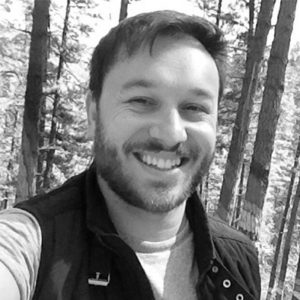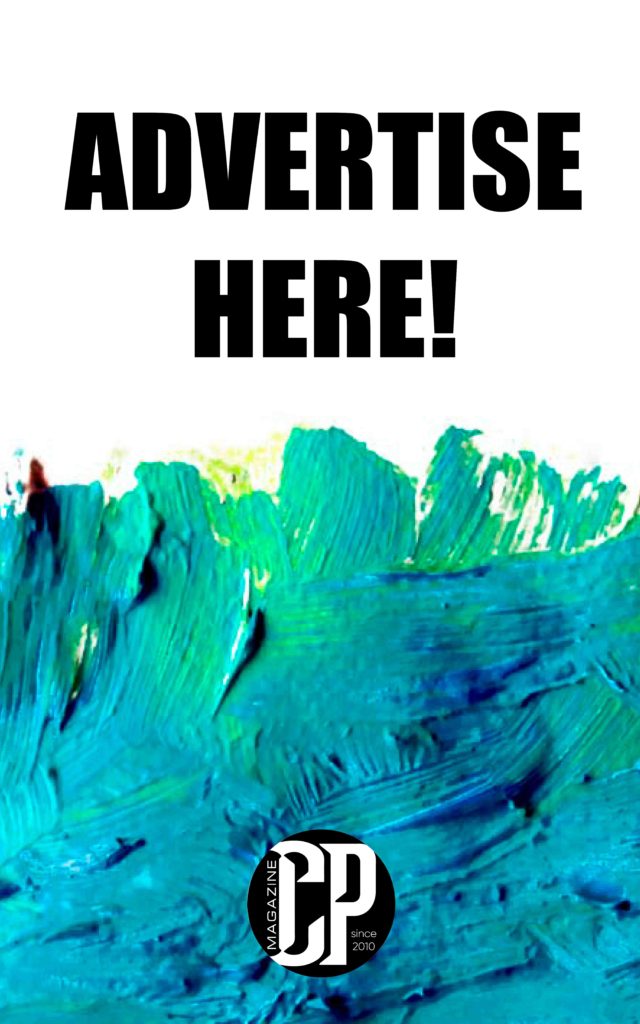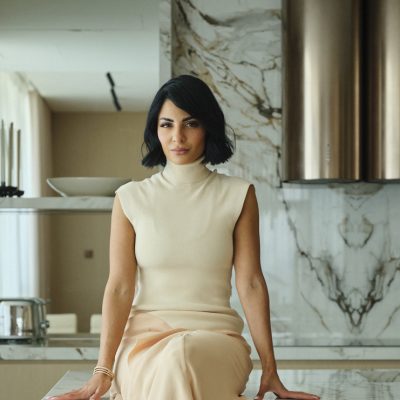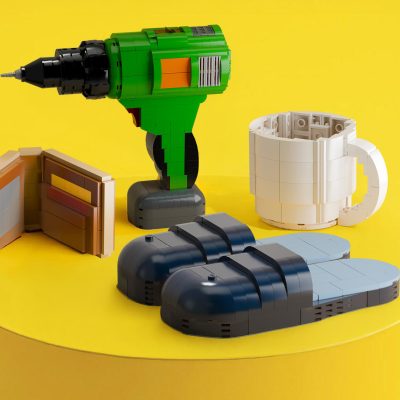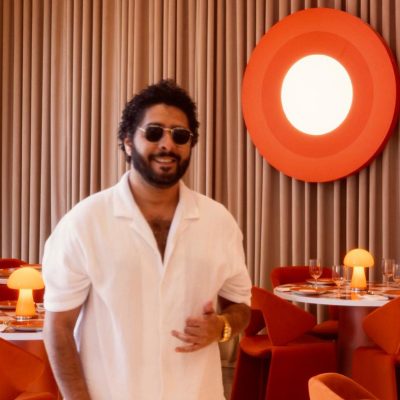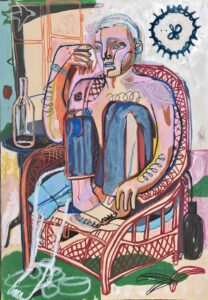
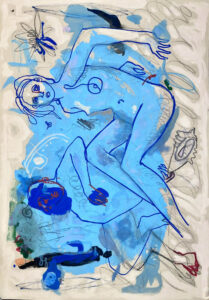

From medieval innovators to avant-garde modern artists, France has a long history of talented painters. Some have risen to worldwide fame and even single-name recognition. An alchemist behind the brush, the Paris-born and raised Simon Buret transforms ordinary objects into objects d’art that are timeless and artistically inspiring. Ranging from bursts of acid-bright colors that commnicate a palpable eroticism to otherworldly innocence, the artist turns his subjects into living ideas of experimental beauty. Filled with colours and an infinite range of symbols, Simon Buret’s paintings transcend the boundaries of time and space by transporting the observer to a poetic realm. Artist, singer, and actor, Buret experiments with various disciplines, which enable him to share his emotions and views on the world.
Buret focuses on creating abstract artworks and universes that retain mixed techniques, inspired by nature and its ability to change regardless of humanity’s actions. He graduated from Auguste Renoir Art School in Paris and the Fine Arts School of Brussels in Belgium. His life in France, Greece and North Africa has strongly influenced his paintings through the patterns, colours and emotive representations.
Buret meets José Berrocoso, our lifestyle editor, to talk about the story behind his paintbrush.
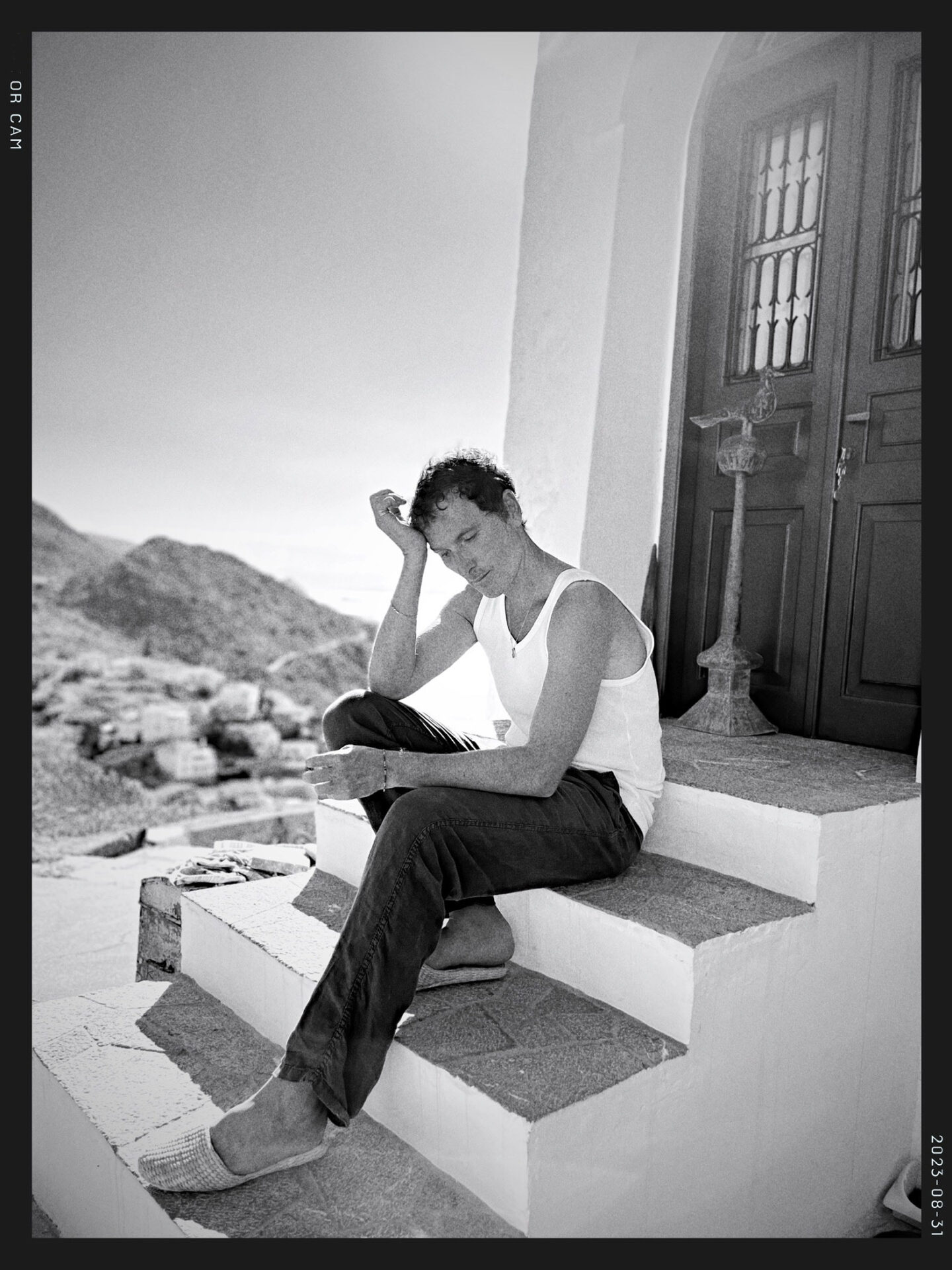
CityPages Magazine: What inspired young Simon Buret to pick up the paintbrush?
Simon Buret: I was an only child raised mostly by my mother, maybe I was lucky, or maybe it was survival kit, but i was a kid with a lot of imagination.
Beside my mother who worked a lot, use to take me to every museum, exhibitions, act of art, concerts, movies… everything that a city like Paris has to offer (which is endless) every week end and Wednesdays; not necessarily for children, just to be in the presence of ART.
It gave me very soon the feeling that everyone has many worlds within the sel; and that art, on a general line, is before anything a connection to the other. I remember being stroke by the power of Miró’s, I have strong memory of statues in the Louvre, ancient Egypt treasures, the twisted mouth of Delacroix horses.
Also, being alone a lot made me create worlds around me; Like most child, I used drawing and painting to express feelings. The magic is to me that it continued within the years. I remember (and it still is today) being excited to see a blank page, a virgin notebook, any blank surface, in front me, it was a world of possibilities wide opening. I also had a very encouraging mother, that clapped every time I would finish a drawing, a poem. Then my studies went naturally towards this artistic world, in which I felt way more at home than the ‘regular’ classes, that never really got my interest.
CPM: Your paintings seem to have an evident relationship between form and colour. Can you share the story behind your fascination with colour?
SB: I don’t know if I am fascinated by colour, I am just willing to express a sense of balance between shapes and masses in the frame space that is given to me. The feeling comes first, and usually what is there when the drawing or painting is finished was not wat I was aiming for when I started; I actually strongly belief that it is the subject that choses you and not the opposite.
I like to let myself drifting on the medium, following the shape of an accidental stain, a hole on the table beneath the support, an “accident” if I can say. Shapes come and go, and step by step, it leads to something that speaks to me, the colour finds its space on or between the lines with the same rhythm. I make couple or “trouple” of colours , uncanny matches if I can say; I try, fail, combine to see how they react and resonate to each others, not necessary the obvious way. I enjoy digging the fact that different layers of colors of the same thickness will give a sense of depth, depending on how where and to which other one they are placed on a two dimensional space.
Also I like to mix ink , and acrylic, greasy chalk , to make (un classical) marriage on the surface.
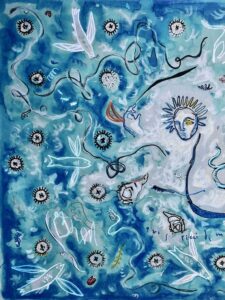

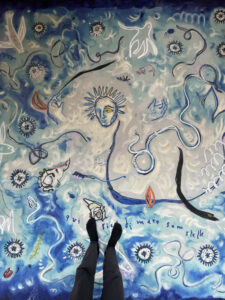
CPM: Your paintings seem to show a micro world, or conversely, a world on a gigantic scale. Are you conscious of this multidimensionality and diversity of scales in your work?
SB: I have to say that I love when a small painting captures the attention of the viewer even more, because I think it is way harder, and much more work for a small composition than with the ones that dominates oneself.
It is to me really easier to be impressed, and taken by what is bigger than us, but when one finds himself in a room in front of something that is smaller than his self, it’s by definition harder to capture the attention; therefore when it happens, It’s even more interesting. The small scale also makes those “objects” an idea of preciousity to me. Little worlds.
On the other hand it is exciting and challenging to me to liberate the energy in a different way when I am asked to work on super large scales, like I did for the Hotel Nolinski in Venice.
CPM: Do you think your paintings’ material sensations and sense of physical actions psychologically affect the viewer?
SB: I hope, yes, and I think that both are intertwined. Obviously there is as many interpretations as they are of viewers, this this what makes art interesting, it is a fifty fifty trip; I love when the door stays open, and I try to keep it in mind when i work, not to impose a special emotion, but to “offers” possibilities of readings; and I love learning that one receive a feeling completely the opposite of another viewer concerning something that I have created. It is the beauty of arts, on a more general matter, too; it helps revealing what we can not tell inside, it elevates, it gives questions sometimes maybe answers. So, when it happens with my works, it is really rewarding. After all, it is the viewer that gives life to what he or her see .the viewer is the final dot to the conversation that I have created.
CPM: Do you think art is a mirror of the artist?
SB: I think art is the mirror to who stands in front of it. It’s always, and only, a revealer of oneself.
CPM: Your paintings seem to have a complex interplay between the intellectual and the visual. Could you share your thoughts on the relationship between both?
SB: It is an eternal waltz between the two; I think I already kind of give the answer in your precedent questions, but to me art is before anything else and expression of self, it is questions and answers given and expressed through the hand that is connected to the brain that command it (and the opposite too) that one wasn’t aware necessarily it was there. In my case, some questions reveal themselves by being brought to the light by the action of painting. I paint something and the painting is made, and a few days later, week, month. I see it again and I’m like “ah, this is what was about”.

CPM: You work between France, North Africa and Greece, mostly. How are the worlds you create in your paintings received among audiences with different cultural, historical, and geographical backgrounds?
SB: I think it’s important for an artist to travel, in mind and physically too. So when I change, place and path, I feel stimulated. Then, to go back to painting, I tend to use timeless references in my painting, meaning there is usually no specific reference that can give a sense of time period, country or clothing that could drive and close the eye in a specific “reference” let’s say. I am more interested in the expressions of feelings than genders.
CPM: Describe your studio space.
SB: An ever-changing mess of notes, gatherings and treasures from everywhere I go, from a restaurant bill, to a leaf, to rocks of which I like the shape of, to brushes, pencils and paint tubes, once in a while organized by colours… books everywhere, and a portable speaker, a picture by Herbert list on the wall and one portrait of “cigarettes bums” by Irving Penn on the other. When I travel to other places or counties, I carry everything in a very weary old aluminum suitcase that makes me look like a secret agent (to my imagination) in airports and train stations; the most that can fit in: ink, acrylic, oil sticks, rolled sheets of paper, small canvas. It’s my favorite outfit, this mess!
CPM: Your solo exhibition “Acrylic.ink.life, on paper”, at the Ofr Gallery in Paris in 2020 was very successful. Can you tell us more?
SB: I started showing my works, on instagram during the first lockdown, because I thought it would be windows, for me to the world, and for others to come in if my paintings, and texts would maybe resonate with. I was not expecting this responses for sure, specially at that period where I felt, like many others pretty fragile, concerning the “outside world”. It was a strange period for everyone, the world felt as if it was ending and at the same time full of possibilities. I think all of us people were their truest at this time. Nothing really was important, nothing maybe but the room we gave to our true fears, and also how we all let our inner demons and dreams rose to the surface of our days. I remember spending most of my time, painting, and watching the course of clouds by the window. And then one day came in my email this wonderful invitation by Alexandre and Marie Thumerelle, the owners of the gallery Ofr. I was over the moon, also because it meant the physical world was not so far ahead, that they were possibilities, still, awaiting.
It was my first ever exhibition of my works, it happened in this specific gallery, that I respect and love since I am in high school. It happened just after France lifted the lockdown in June, everyone wanted to be in life again; I guess I was lucky on that to, that people were excited to have plans offer; and it was one of the first events in witch one could reunite in my neighborhood. I had no idea what to expect. Ofr were confident, and very exciting to work with. We hanged 48 paintings on their walls, a large bouquet of flowers were sent from my father and a plaster bust sculpture of a Greek god that is always posed on my table, as a guardian dominating my works in my Parisian studio.

CPM: In June 2023, you created a 44 square meter fresco for the ceiling of a Palazzo in Venice. How was the experience? How long have you been developing the project?
SB: The project on its whole, on my part, took about 2 years all together. It’s really hard to describe it, I was lucky enough to spend almost a month alone in a Venetian Palazzo, in the silent of its walls, a few meters away from the Saint Marc Piazza. The room I worked in was filled with past energies, 10 meters high ceiling, ancient sculptures carved in the doors and walls this place itself (ancient chamber of commerce) was already a true gem, and the whole building felt as an empty sleeping beauty. I had to train myself not to be too impressed to be able to create something that would be a true marriage between this infinite old world and my imagination. Venice has so many treasures, it was a challenge to let my self go and humbly try to connect to its history, and take something there and express it on the ceiling I was given to work on.
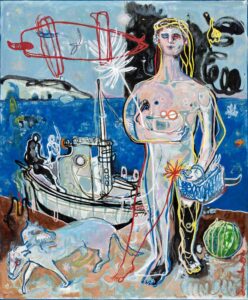
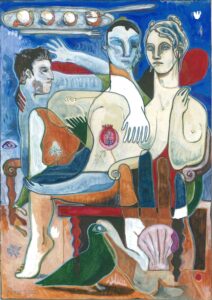
During the weeks hundreds of people was working in the other levels during day time, and soon I understood I should change my shift to work at night, being only disturbed by the presence of silence. So during the day I would scroll the city, loose myself in those narrow streets, all this maze of history that is unbelievably made, were every door, wall, angle seems to have a story to tell, waiting there for centuries to be seized be the willing eye.
And then at 6 pm, I would go back to the future hotel, when everyone left, only the night guard and myself; and I would start putting on the canvas, what I saw, the feelings I’d received from the day.
CPM: What are the similarities and differences between this specific work and those of your previous series in canvas?
SB: The major difference I would say is that it was in a way a (command), even if the subject remained free on most angle. And what I usually work on comes from dreams, emotions, non digested events you know thing I have the urge to talk and create about.
This was literally the opposite, I had to find the matter, whether usually I tend to believe the matters finds me in a way.
CPM: Tell me about the mood painted within your latest art series.
SB: I don’t really do series, every painting is a different feeling, fixed or that is what I think it is maybe. It is only when I look at them all together, as for a time of exhibition for example, that I understand what I am talking about.
CPM: What are Simon Buret’s artistic plans for 2023 and beyond?
SB: To infinity, and beyond 🙂


